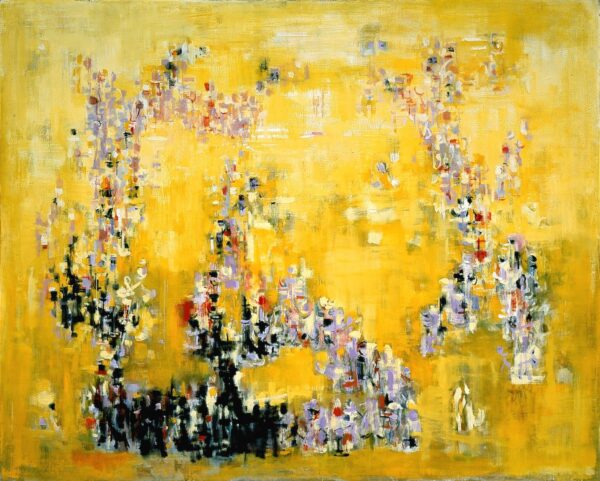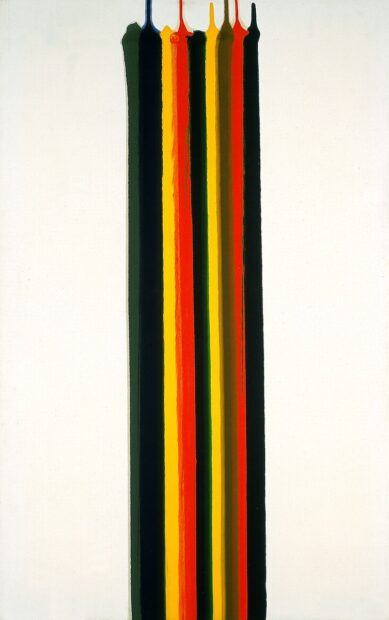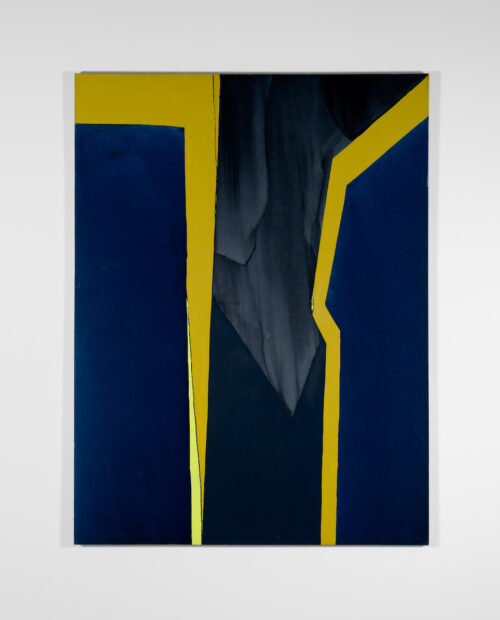
Norman Lewis, La Puerto Del Sol, 1958, oil on canvas, 51 1/4 x 63 3/4 in., Blanton Museum of Art, The University of Texas at Austin, Gift of the Longview Foundation, Inc., 1960. © Estate of Norman Lewis; Courtesy of Michael Rosenfeld Gallery LLC, New York, NY
American artist Alma Thomas’s acrylic painting, Jonquils (1973), is a yellow and gold field of daffodils that fit like puzzle pieces across the canvas. It’s a powerful work that exemplifies many of the themes of light and color characteristic of abstract painters in the mid- to late-20th century.
Although artists began exploring abstract and nonrepresentational forms early on in the 20th century, the ensuing decades saw them push boundaries between media, explore new mediums (including acrylic paint), and consider that the action or gesture of creating a piece was just as much part of the work as was the material it was made of. If anything, these new directions emphasized that 20th-century art was not a static entity, either in its creation or in the emotion that it invoked in its viewers. It was ever-moving and ever-changing: ever-expanding.
![Rogelio Polesello, Dos diagonals [Two Diagonals], 1980](https://glasstire.com/wp-content/uploads/2020/10/1991.418-600x608.jpg?x88956)
Rogelio Polesello, Dos diagonals [Two Diagonals], 1980, acrylic on canvas, 63 3/8 x 63 3/8 in., Blanton Museum of Art, The University of Texas at Austin, Gift of Barbara Duncan, 1991
![Agustín Fernández, "Armadura, series no. 18 [Armor, series no. 18]," 1973c](https://glasstire.com/wp-content/uploads/2020/10/P1973.11.1-510x620.jpg?x88956)
Agustín Fernández, Armadura, series no. 18 [Armor, series no. 18], 1973, oil on canvas, 66 5/8 x 55 1/4 in., Blanton Museum of Art, The University of Texas at Austin, Archer M. Huntington Museum Fund

Morris Louis, Water-Shot, 1961, oil on canvas, acrylic [synthetic polymer] on canvas, 84 1/2 x 53 1/4 in., Blanton Museum of Art, The University of Texas at Austin, Gift of Mari and James A. Michener, 1991. ©1961 Morris Louis

Dorothy Hood, Space Bolts V, 1967, oil on canvas, 80 x 60 in., Blanton Museum of Art, The University of Texas at Austin, Gift of Robert L. Hardgrave, Jr., 1984; Gift of The Contemporary Austin to the Blanton Museum of Art, 2017
And introduction of acrylic paint challenged notions of “flatness” in perspective, particularly as mid-20th century artists explored new tools with which to apply it. (“Some artists … explored spraying paint using industrial tools like air guns.”) But “flatness” was also challenged as works began to bridge traditionally observed boundaries between painting and sculpture. Most if not all of the works here offer myriad non-traditional (and some even non-canvas) textures to create new dimensionalities.
![Alejandro Puente, Estructura (3 panels) [Structure (3 panels)], 1966](https://glasstire.com/wp-content/uploads/2020/10/Alejandro-Puente-_Estructura-3-panels_-522x620.jpeg?x88956)
Alejandro Puente, Estructura (3 panels) [Structure (3 panels)], 1966, oil on canvas, 74 13/16 x 63 x 78 3/4 in., Blanton Museum of Art, The University of Texas at Austin, Purchase as a gift of Margaret McDermott in honor of Barbara Duncan, and Judy S. and Charles W. Tate, 2005
The works in Expanding Abstraction exemplify what art critic Harold Rosenberg described as the mid-20th century’s abstract expressionism: “an arena in which to act.” (Rosenberg termed it “Action Painting” in 1952.) For materials that challenge traditional notions of exhibition (like Davidovich’s tape), the creation of the piece is part of that arena.

Richard Anuszkiewicz, Plus Reversed, 1960, oil on canvas, 74 5/8 x 58 1/4 in., Blanton Museum of Art, The University of Texas at Austin, Gift of Mari and James A. Michener, 1991. Art © Richard Anuszkiewicz/Licensed by VAGA, New York, NY
That dynamism isn’t limited to the creation of the pieces. Understanding that each piece is active — moving, changing, expanding — is exemplified by the paintings that explore optical illusion. Richard Anuszkiewicz’s Plus Reversed (1960) and Tadasky’s (Tadasuke Kuwayama) C-109 (1964) notably visually “shift” depending on where one stands to view them. And as acrylic paint can produce very specific and crisp lines, it was ideally suited for the sorts of interlocking graphics required to create these moving optical illusions, known as the moiré effect. (Oil paints can deliver this as well.) And the motor, light, plexiglass, and water of Gyula Kosice’s Hidroluz (Hydrolight) (1975) push illuminated little bubbles up the wooden box. Here, the movement is literal.
What’s evident throughout this nuanced and thoughtful show is just how much artists in the Americas found new ways to explore and expand on notions of light, color, and materiality during this time. It’s a welcome feast for the eyes.
On view through Jan. 10, 2021 at Blanton Museum of Art, UT Austin.


